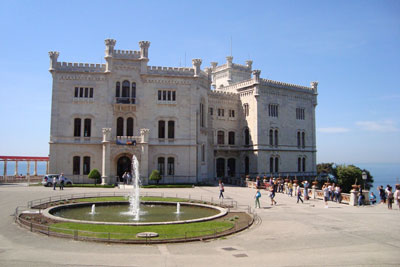Touring Trieste
This item appears on page 30 of the January 2013 issue.
Having paid $24 for a first-class one-way ticket, I was enjoying a relaxing train ride in Italy with no worries about when and where I was supposed to get off because my destination, Trieste, was the end of the line. The station was on one level, as in Venice, where I boarded, so there were no stairs to deal with, either.
With directions from a kind older lady, I turned right upon exiting the station. Do not turn left if you have luggage or you will have to go down a long flight of stairs that lead underground, then climb back up again.
My hotel, Albergo alla Posta (phone 011 39 040365208), on via Carducci facing Piazza Oberdan, was about a 12-minute walk from the station.
This super-clean, air-conditioned 3-star hotel (which I booked at Booking.com) honored all of my requests: accommodations on an upper floor, a quiet location, a bathtub and a comfortable reading chair. My dormered single room faced the circle of streets below, but the large window was exceptionally soundproof and I didn’t hear any traffic noise unless I opened it. (The single rate is €98-€110 [near $127-$142] per week night or €70 [$90] per weekend night with a 2-night minimum.)
The breakfast room was cozy and charming, with a couch at the entrance for reading the many daily international newspapers available. The food selection and service were very nice.
From the helpful people at the front desk, I learned that a bus stop was just around the corner, and the tram/cog railway that travels 25 minutes up to the community of Opicina (€3.50 round trip) was right in front of the hotel. (The hotel sells tickets for each.)
The weather was exceptionally hot and muggy while I was in Trieste (May 9-13, 2012), so my energy level wasn’t at its peak. However, early one morning I took a 30-minute bus ride (€2.30 round trip) along the coast to the Castello di Miramare (entry, €6), a white castle situated on a headland jutting into the Gulf of Trieste.
The park that surrounds the castle extends over roughly 55 acres, the part near the castle a mix of botanical, English and Italian-style gardens, all with rare and exotic plants.
This is the must-see attraction of the Trieste area. Visitors should get off the bus at the next-to-last stop to enter Miramare through the back of its magnificent park, shady with oaks, firs and cypresses.
When I finished my visit, I made the mistake of exiting the property from the lower, tour-bus entrance approaching the castle, which took me on a wide, paved path along the (by then) much-too-hot waterfront. Passing many small hotels to my left, I saw throngs of very pink to deeply tanned bodies being sunned either on the low concrete wall that divided them from the sea or on the uncomfortable rocks below. It was not a pretty sight.
The tram to Opicina was built in 1902 and resembles an early streetcar. It links the city center with the plateau and affords an amazing view of the city and gulf. Get off at the Obelisk (Obelisco) stop, before reaching Opicina, in order to access the panoramic promenade that leads to the town of Prosecco.
From Alla Posta, it was a 10- to 15-minute walk to both the old and “new” part of Trieste as well as to the harbor. In order to see and be seen, this is where the locals take their passeggiata (stroll).
Although I walked everywhere, tickets are sold in most major hotels for the hop-on/hop-off buses (€18).
I had also wanted to take a ferry to Piran, Slovenia, with its pastel-colored buildings, but I was told that it runs only during summer.
On certain days there are various markets, but the one on Piazza Ponterosso, along the interesting Canal Grande that runs from the harbor to the center of the city, is open 8 a.m. to 5:30 p.m. Tuesday through Saturday.
Trieste’s Piazza Unità d’Italia is one of the largest squares I have ever seen. It is U-shaped, opening to the sea, and framed by exceptionally white buildings. It includes the Palazzo del Governo (Government Palace), Town Hall and many other beautiful palazzos. The Verdi opera house, shops, historic cafés, tourist information center and a huge gelateria are nearby. Like many areas of the town, this one is “pedestrian only.”
On a suggestion from the hotel for a family-run restaurant, I had lunch at the nearby Osteria de Scarpon (via della Ginnastica 20; phone 040 37674). Although the insalata mista (“mixed green salad,” €3) with slivered carrots and tomatoes was lackluster, the linguini con vongole (“with clams,” €9) was outstanding. There must have been at least 50 tiny clams in the dish — so many that I couldn’t eat them all!
The night before I left, the heat wave finally broke with typical white lightning and loud thunder. It was still raining hard the following morning, so, rather than walk as I had planned, I was forced to take a taxi to the station (€9, which was higher than normal because of the weather and the demand).
An Italian teacher once told me that Trieste made her feel sad, but another Italian friend said she loved the area. Go and decide for yourself!
MARILYN HILL
Portland, OR

